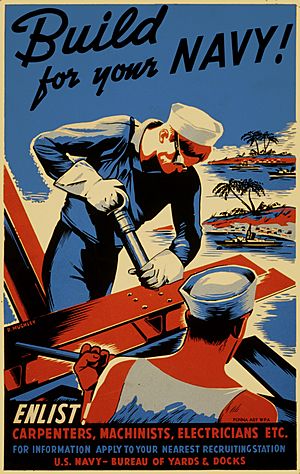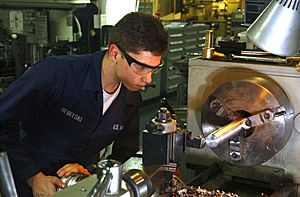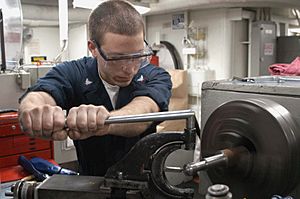Machinist facts for kids

A machinist is a skilled person who uses special tools to shape and create parts. These parts can be made from metal, plastic, or wood. Machinists use both hand tools and big machines to make new parts or fix old ones. They are like artists who sculpt materials, but for machines and products!
Contents
What Do Machinists Do?
Different Kinds of Machinists
A machinist is someone who is good at working with machines. They can operate tools, fix them, and even make new parts for machines. They might build gears, shafts, or other complex pieces.
Sometimes, a machinist might have a special title. For example, a "fitter" puts parts together. A "tool and die maker" creates special tools for other machines. A "programmer" might write instructions for computer-controlled machines. Depending on where they work, a machinist might do one or all of these jobs! Their main role is to solve problems by making or fixing parts.
Machinists in Manufacturing
Machinists are very important in making new products. When a company needs a part made from metal or plastic, they often call a machinist. This could be a single, unique part or thousands of identical parts for a production line.
Making a part often involves many steps and different machines. Each machine helps cut away extra material. For large orders, machinists plan the best way to move parts through different machines.
Computer-Controlled Machines
Many modern machines are Computer Numerical Controlled (CNC). This means a computer tells the machine exactly what to do. CNC machines are very fast, precise, and flexible. They can make many different shapes and are great for making lots of parts quickly.
When many parts are needed, it's called "production work." Making just a few parts, like for a new invention, is called "prototype" or "jobbing work."
Engineers draw detailed plans for parts. Then, machinists set up the machines to follow these plans. They also work with quality control teams to make sure every part is made perfectly.
Many big companies have machinists on staff. These machinists help keep the production machines running smoothly. This saves the company a lot of money by preventing costly shutdowns.
Additive Machining: 3D Printing
Some machinists also work with "additive machining," which is another name for 3D printing. This process builds up parts layer by layer. It's great for making very small or complex parts that would be hard to make any other way.
There are different ways to 3D print. Some methods use lasers to melt metal powder. Others use electron beams or melt plastic filaments. These techniques help create industrial parts, prototypes, and even final products.
Materials Machinists Work With
A machinist shapes metal, just like a woodcarver shapes wood. The most common materials they use are steel, aluminium, brass, and copper. They also work with different alloys, which are mixtures of metals.
Sometimes, they work with less common metals like vanadium or zinc. They also occasionally work with plastics, rubber, glass, and wood.
Special Metals
"Exotic metals" are special or rare metals. These might include titanium, beryllium, or tungsten. They also work with "superalloys" like Inconel, which are very strong and can handle high temperatures. Working with these special metals often needs unique tools and methods.
The tools machinists use to cut materials must be harder than the material itself. Common cutting tool materials include high speed steel, tungsten carbide, ceramics, and even diamond.
Precision Work
Machinists work with incredible precision. They often need to make parts within a tiny fraction of an inch or millimeter. For example, a common tolerance might be plus or minus 0.010 inches (0.25 mm). For very special jobs, it can be as small as 0.0001 inches (0.0025 mm)! This means the part must be almost exactly the right size.
Machinists perform many operations to shape materials. The most common ones are:
- Milling: Using a rotating cutter to remove material.
- Drilling: Making holes.
- Turning: Spinning the material against a cutting tool, often on a lathe.
- Grinding: Using an abrasive wheel to smooth or shape a surface.
Tools of the Machinist
Machinists use many different tools. These tools fall into several main groups:
- Measuring tools: These help machinists check sizes and make sure parts are accurate.
- Some tools compare sizes, like calipers.
- Others give direct readings, like rulers or micrometers.
- Digital tools use electronics to show measurements on a screen.
- Hand tools: These are common tools you might find in a mechanic's toolbox, like wrenches and screwdrivers.
- Machine tools: These are the big machines that do the cutting and shaping. In the past, there were separate machines for drilling, milling, turning, and grinding. Today, many of these jobs are done by CNC machines that can do multiple tasks.
- Work holders: These tools hold the material firmly in place while it's being worked on. Examples include vises and chucks.
- Tool holders: These hold the cutting tools securely in the machine.
- Cutting tools: These are the actual tools that cut the material. They include different types of drills, reamers, taps, and various milling cutters.



